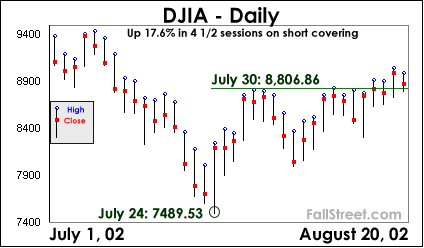|
With traders and investors basking in the sun preparing for the grueling days of September, August is typically a mundane month. However, if you are following the markets during August 2002 you will undoubtedly believe that August has been full of bullish glee. That is, of course, until you remember what took place in July.
 |
To begin with, the above chart’s bias is that the rally from July 24-July 30 was induced by spectacular waves of short covering. That the NYSE only provides short selling data on a monthly basis limits this theory, because the July 11-July 30 data will not be reported until the August numbers arrive (month ended August 12). Nevertheless, this is what has logically transpired since July:
1) Record short interest in the markets was rattled by rumors of a secret Fed meeting (who would dare short U.S. stocks if it was believed that Greenspan was preparing a 1987 like statement to bail the markets out?)
2) As shorts began to cover program trades padded gains, and a handful of corporate buyback announcements came down the pipe (not unlike 1987, companies quickly made their buyback announcements following the first sign of a bottom (see range/high/close for July 24). For the month of July more than 100 companies announced plans to buy back $43.2 billion in stock.)
3) Brazil was handed $30 billion, speculation of a Fed cut materialized, and CEO certification passed without a major incident. For whatever reason, these occurrences have helped the markets.
So there you have it – the Dow is up all of 65 points since July 30. Does this huge move mean that the markets are reacting to positive fundamental developments (i.e. improving earnings outlook or better than expected economic performance)? No. Rather, steep losses in July followed by a quick rebound helped assure some investors that the markets had reached a bottom
Despite meager gains since late July, some people would have you believe that everyone purchased stocks right at the ‘bottom’ and are cashing in spectacular profits today. However, and remember this point well -- record redemptions were being tabulated right at the ‘bottom’. As such, beyond corporate America and the shorts, who was really buying?
With these things in mind, it should be remembered that the current market has limitations. For certain, volume has been on the weak side as of late, the corporate buyback binge is over and will not return en masses unless prices plunge again, and mutual funds are likely to see further redemptions in August, albeit at a slower pace than in July. As redemptions cancel out buybacks the argument could be made that the markets are not acquiring any new liquidity, save asset allocation shifts from bonds to stocks. How does a fully ‘distributed’ market with no injection of new liquidity continue to rally? It doesn’t.
Volume is Key
Watch the directional volume heading into September. Upon returning from vacation it may not take traders and investors long to figure out that despite all the excitement the situation (earnings & economy) has deteriorated significantly since July.
All data and information within these pages is thought to be taken from reliable sources but there is no guarantee as such. All opinions expressed on this site are opinions and should not be regarded as investment advice.
Copyright © 2000, 2001, 2002
FallStreet.com
|
|
|
|